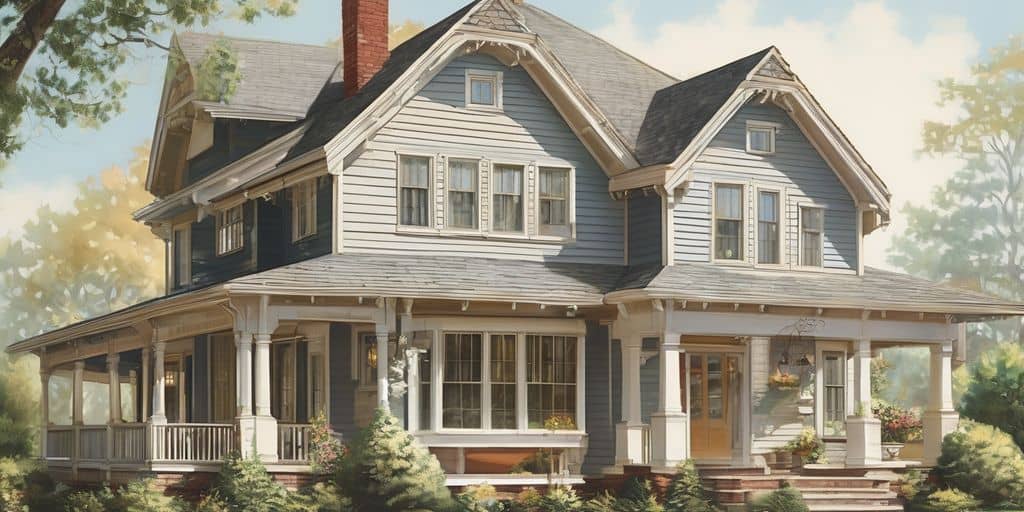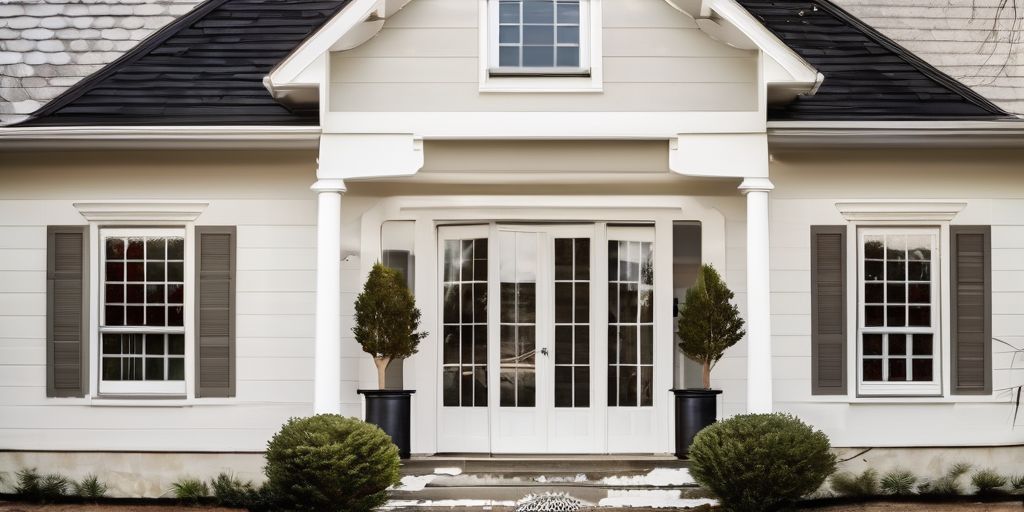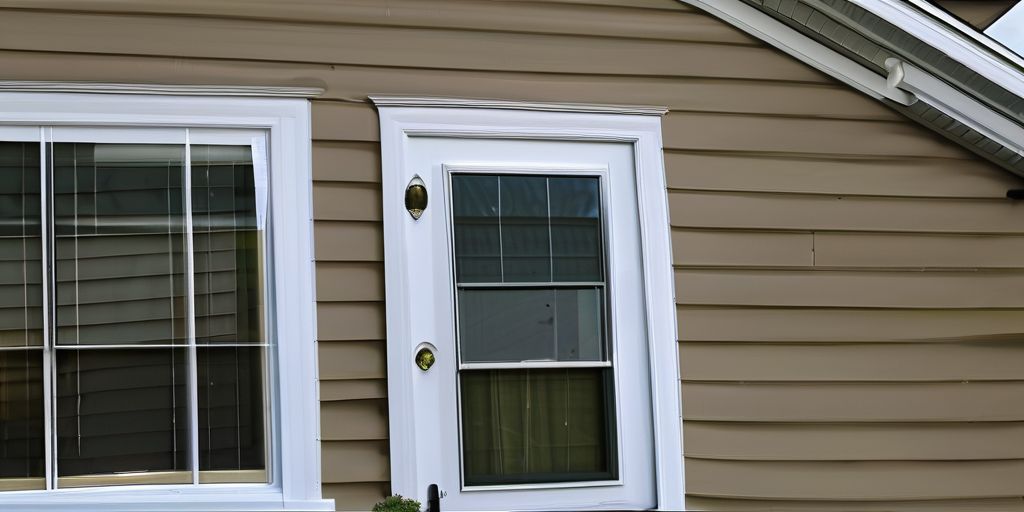Vinyl siding has come a long way since it first appeared on homes. This article explores how vinyl siding colors have changed over the years, the impact of different architectural styles and regions on color choices, and the role of texture and energy efficiency in selecting the perfect siding. We’ll also look at how to maintain and update vinyl siding colors to keep your home looking its best.
Key Takeaways
- Vinyl siding colors have evolved from simple, popular shades to more earthy tones and bold, dark hues.
- Architectural styles, like Colonial and Midcentury Modern, influence the choice of vinyl siding colors.
- Regional preferences, such as coastal versus inland areas, play a role in vinyl siding color trends.
- Textures, like wood-look finishes, can enhance the appearance of vinyl siding colors.
- Choosing the right vinyl siding color can also impact your home’s energy efficiency.
The Evolution of Vinyl Siding Colors Over the Decades
Early Adoption and Popular Colors
In the early days of vinyl siding, homeowners often chose simple and practical colors. White, beige, and light pastels were the go-to options. These colors were not only easy to maintain but also complemented a wide range of architectural styles. White was especially popular for its clean and timeless look.
The Rise of Earthy Tones
As the years went by, there was a noticeable shift towards more natural and earthy tones. Colors like brown, green, and tan started to gain popularity. These shades blended well with natural surroundings and gave homes a more grounded appearance. This trend was partly driven by a growing interest in eco-friendly and sustainable living.
Modern Bold and Dark Hues
In recent years, homeowners have become more adventurous with their color choices. Bold and dark hues like navy blue, charcoal, and even black are now in vogue. These colors make a strong statement and can significantly enhance a home’s curb appeal. The use of innovative design ideas for painting vinyl siding has made it easier to achieve long-lasting results with these daring colors.
The evolution of vinyl siding colors reflects broader trends in home design and personal expression. From the early days of simple pastels to today’s bold and dark hues, the journey has been both exciting and colorful.
Influence of Architectural Styles on Color Choices
Colonial and Traditional Homes
Colonial and traditional homes often feature classic color schemes that have stood the test of time. These homes typically use:
- Whites and off-whites
- Soft pastels
- Muted blues and greens
These colors help maintain the elegant and timeless look that is characteristic of these architectural styles.
Midcentury Modern Homes
Midcentury modern homes embrace bold and vibrant colors. Popular choices include:
- Bright oranges and yellows
- Rich browns and greens
- Deep blues and teals
These colors reflect the innovative spirit of the mid-20th century and add a touch of retro flair to the home.
Contemporary Designs
Contemporary homes often feature a mix of neutral and bold colors to create a sleek and modern appearance. Common color choices are:
- Grays and blacks
- Crisp whites
- Bold accent colors like red or navy
Combining these colors with modern architectural elements can give your home a striking and sophisticated look.
Impact of Regional Preferences on Vinyl Siding Colors
Coastal vs. Inland Choices
When it comes to choosing vinyl siding colors, regional preferences play a significant role. Coastal areas often favor lighter shades like whites, beiges, and light blues. These colors not only reflect the serene coastal environment but also help in reducing heat absorption. Inland regions, on the other hand, tend to opt for earthy tones such as browns, greens, and grays, which blend well with the natural surroundings.
Urban vs. Suburban Trends
Urban areas usually lean towards modern and bold colors. Dark hues like navy blue, charcoal, and even black are popular choices. These colors give a sleek and contemporary look to homes. In contrast, suburban areas often prefer more traditional and neutral colors like beige, light gray, and soft greens. These shades provide a timeless appeal and blend well with the suburban landscape.
Climate Considerations
Climate also influences vinyl siding color choices. In hotter climates, lighter colors are preferred as they reflect sunlight and help keep homes cooler. Conversely, in colder regions, darker colors are more popular because they absorb heat, helping to keep homes warmer. It’s essential to consider the local climate when selecting a vinyl siding color to ensure both aesthetic appeal and energy efficiency.
When selecting your vinyl siding color, think about the long-term impact it will have on your home’s aesthetic and resale value.
The Role of Texture in Enhancing Vinyl Siding Colors
Wood-Look Finishes
Wood-look finishes in vinyl siding offer the charm of traditional wood without the upkeep. These finishes can mimic the appearance of cedar or oak, providing a natural and warm look to your home. Expert advice on achieving professional results in vinyl siding painting often includes choosing the right texture to complement your color choice. Popular options include:
- Authentic wood grain
- Shadow lines
- Smooth finishes
Smooth vs. Textured Surfaces
When deciding between smooth and textured surfaces, consider the overall style of your home. Smooth surfaces provide a sleek, modern look, while textured surfaces add depth and interest. Tips on color choice, paint quality, and Benjamin Moore colors for vinyl siding can help you make an informed decision. Here are some points to consider:
- Smooth surfaces are easier to clean
- Textured surfaces can hide minor imperfections
- The choice can affect the home’s curb appeal
Combining Colors and Textures
Combining different colors and textures can create a unique and personalized look for your home. This approach allows for creativity and customization, ensuring your home stands out. Reducing color fade on Mississauga’s dark vinyl siding involves understanding UV rays, weather impact, and maintenance. Here are some ideas:
- Pairing light and dark colors
- Mixing smooth and textured panels
- Using contrasting trim for emphasis
Remember, while color is crucial, the texture of your vinyl siding can be just as impactful. It’s about finding the perfect match for your home’s style and ensuring it stands out in the neighborhood.
Energy Efficiency and Color Selection
Reflective Properties of Light Colors
Choosing light colors for your vinyl siding can have significant benefits. Light colors reflect more sunlight, which helps keep your home cooler during hot months. This can lead to lower energy bills as your air conditioning system won’t have to work as hard. Reflective properties of light colors make them a popular choice for energy-conscious homeowners.
Heat Absorption of Dark Colors
Dark colors, on the other hand, absorb more heat. This can be beneficial in colder climates where extra warmth is needed. However, in warmer regions, dark colors might increase your cooling costs. It’s essential to consider your climate when selecting a color for your vinyl siding.
Energy Star Ratings and Vinyl Siding
Some vinyl siding products come with Energy Star ratings, indicating they meet specific energy efficiency criteria. These products can help improve your home’s thermal performance and reduce energy consumption. Look for the Energy Star label when shopping for vinyl siding to ensure you’re making an energy-efficient choice.
Remember, the color you choose will be a part of your home’s identity for years to come. It’s worth taking the time to select a color that you’ll be happy with in the long term, reflecting both your personal style and practical considerations.
Maintaining and Updating Vinyl Siding Colors
Cleaning and Care Tips
Keeping your vinyl siding clean is essential for maintaining its appearance and longevity. Here are some tips to help you:
- Use a soft brush or cloth to remove dirt and grime.
- Mix a homemade cleaner with water and mild detergent for gentle cleaning.
- Rinse thoroughly with a garden hose to avoid soap residue.
Regular maintenance helps prevent buildup and keeps your siding looking fresh.
Repainting and Color Refreshing
If your vinyl siding’s color has faded or you want a new look, repainting is an option. Follow these steps:
- Clean the siding thoroughly before any work begins.
- Inspect for any damage or areas that may need repair.
- Choose latex-based paints for better durability and UV protection.
- Avoid oil-based paints to prevent peeling and other issues.
Repainting can give your home a fresh, updated appearance.
Long-Term Durability
To ensure your vinyl siding lasts, consider these factors:
- Opt for sun-resistant colors with UV inhibitors.
- Regular maintenance and proper caulking protect against color fading and sun damage.
- Professional installation and upkeep are crucial for long-term durability.
Remember, the preparation of your home’s exterior is just as important as the color choice. A clean and well-inspected surface ensures that your siding will look its best and last for years to come.
Popular Vinyl Siding Colors in 2023
Trending Earthy Tones
In 2023, homeowners are increasingly drawn to eco-friendly options for painting vinyl siding. Earthy tones are making a strong comeback, with shades like greys, beiges, and greens leading the way. These colors not only blend seamlessly with natural surroundings but also offer a timeless appeal.
- Greys: Versatile and modern, greys can suit various architectural styles.
- Beiges: Warm and inviting, beiges add a cozy touch to any home.
- Greens: Reflecting nature, greens bring a refreshing vibe to exteriors.
Bold and Dark Hues
Bold and dark hues are also gaining popularity this year. Homeowners are stepping away from traditional palettes to make a statement with their exterior color choices. Deep reds and navy blues are among the top picks.
- Navy Blue: Offers a sophisticated and modern look.
- Deep Reds: Adds a touch of elegance and boldness.
Timeless Neutrals
Timeless neutrals continue to be a favorite for many. These colors are versatile and can easily match various design elements. Whites, creams, and light greys are particularly popular.
- Whites: Classic and clean, whites never go out of style.
- Creams: Soft and subtle, creams provide a gentle backdrop.
- Light Greys: Modern and sleek, light greys are perfect for a contemporary look.
Bold and dark hues are not just a trend; they are a way to express individuality and make a lasting impression. Whether you choose earthy tones, bold colors, or timeless neutrals, the right vinyl siding color can significantly enhance your home’s curb appeal.
Discover the hottest vinyl siding colors of 2023 and give your home a fresh, modern look. Our expert team at We Paint Siding specializes in transforming old, faded vinyl into stunning exteriors. Ready to see the difference? Visit our website to explore our services and book your free estimate today!
Conclusion
In wrapping up our journey through the history of vinyl siding paint colors, it’s clear that the choices available today are more diverse and exciting than ever before. From classic whites and neutrals to bold, modern hues, there’s something for every taste and style. Vinyl siding not only protects your home but also allows you to express your personality and enhance your home’s curb appeal. Whether you’re drawn to timeless designs or the latest trends, the right color can make a world of difference. So, go ahead and explore the vibrant world of vinyl siding colors to find the perfect match for your home.
Frequently Asked Questions
What are the current trends in vinyl siding colors for homes?
Current trends in vinyl siding colors include a variety of earthy tones like greys, beiges, and greens. Bold, dark hues such as navy blue and deep reds are also popular. Textured finishes that look like natural materials, like wood, are in demand too, adding a modern yet timeless look to home exteriors.
How does vinyl siding contribute to a home’s energy efficiency?
Vinyl siding can help improve a home’s energy efficiency by providing an extra layer of insulation. Light-colored vinyl siding can reflect sunlight, keeping homes cooler in hot weather, while dark-colored siding can help retain heat in colder months.
What factors should I consider when choosing a vinyl siding color?
When choosing a vinyl siding color, consider your home’s architectural style, the surrounding environment, and how long you want the color to last. It’s also a good idea to test a few colors to see how they look with your landscaping and neighboring homes.
How do I maintain and clean vinyl siding?
To maintain and clean vinyl siding, regularly rinse it with a garden hose to remove dirt and debris. For tougher stains, use a soft brush and a mixture of water and mild detergent. Avoid using harsh chemicals or pressure washers, as they can damage the siding.
Can I repaint vinyl siding if I want to change the color?
Yes, you can repaint vinyl siding if you want to change the color. Make sure to clean the siding thoroughly and use a high-quality exterior paint designed for vinyl. It’s best to choose a color that is lighter or similar to the original to avoid potential warping.
What are the most popular vinyl siding colors in 2023?
In 2023, popular vinyl siding colors include earthy tones like sage green and taupe, bold and dark hues such as deep blue and charcoal, and timeless neutrals like beige and white.





